Raisin Cinnamon Bread
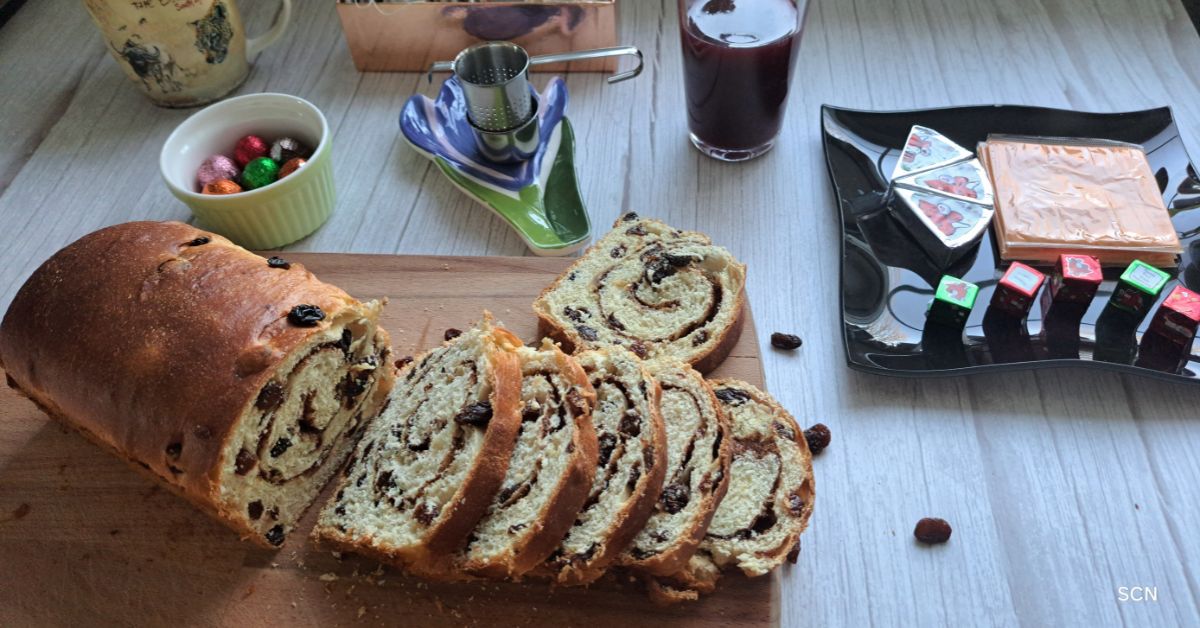
The Raisin Cinnamon Bread combines the sweet goodness of plump raisins with the warm flavour of cinnamon. Made with simple ingredients including flour, yeast, sugar, cinnamon, raisins, and a dash of salt. Each slice is a perfect balance of sweetness and spice. Perfect for breakfast, snack time, or any time of the day.
Raisins and cinnamon play integral roles in enhancing the flavour and texture of Raisin Cinnamon Bread. Raisins contribute natural sweetness and a burst of fruity flavour to the bread. Their soft texture contrasts beautifully with the bread’s crumb, adding pops of juicy goodness in every bite. As the bread bakes, the raisins soften slightly, adding a chewy, succulent texture that contrasts with the tender crumb of the bread. Similarly, cinnamon infuses the bread with warm, spicy notes, creating a comforting aroma and taste that complements the sweetness of the raisins. Adding these ingredients to the bread enhances its taste and adds nutritional value.
Ingredients
Each ingredient plays a crucial role in creating the texture and flavour of Raisin Cinnamon Bread.
Flour: The flour provides the structure and texture of the bread. It contains gluten, which gives the bread its elasticity and helps it rise.
Yeast: Responsible for leavening the bread, yeast consumes sugars in the dough and produces carbon dioxide gas, causing the dough to rise. This creates the airy, light texture characteristic of bread.
Sugar: Adds sweetness to the bread and also provides food for the yeast to activate and grow. It helps to balance the flavours and contributes to the golden-brown crust during baking.
Salt: Enhances the flavour of the bread by balancing the sweetness. It also regulates the yeast activity, improves the dough’s texture, and helps control fermentation.
Cinnamon: Infuses the bread with a warm, aromatic flavour and adds a hint of spice. Cinnamon is a key ingredient that gives the bread its distinct taste and aroma.
Raisins: Sweet, chewy, and packed with flavour, raisins add bursts of sweetness and texture to the bread. They contrast the soft crumb and complement the cinnamon flavour beautifully.
Water or Milk: Serves as the liquid component in the dough, hydrating the flour and activating the yeast. Milk adds richness to the bread and soft, tender texture.
Butter/oil: Adds richness, moisture, and flavour to the bread. It helps tenderize the crumb and contributes to a soft, buttery texture.
Read more about the yeast here.
Are you looking for another festive treat? Try our soft and flavourful Panettone—a perfect addition to your holiday table!

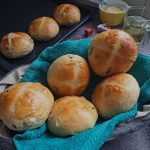
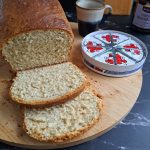
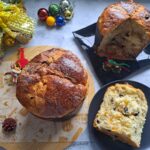
Bring holiday cheer to your table with our Christmas Wreath Bread filled with savoury spinach pesto — a delightful complement to the sweet warmth of our raisin cinnamon bread!
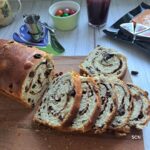
Raisin Cinnamon Bread
Ingredients
1 cup = 250ml
- 2 cups All purpose flour 270g
- ¼ cup fine-grained sugar 30g
- ½ tsp salt
- 1 room-temperature egg
- 2 ½ tsp instant yeast
- 3 tbsp oil/melted unsalted butter
- ¾ cup luke-warm milk (110 – 140ml)
- 1 cup raisins 140g
For the filling
- ¼ cup brown sugar 30g
- 1 tbsp cinnamon
- 2 tbsp room-temperature unsalted butter
Instructions
- In a large mixing bowl or a stand mixer bowl, combine the flour, sugar, yeast, egg, salt and oil. Combine everything well.
- Add lukewarm milk slowly into the mixture, until a dough forms, then continue kneading in the stand mixer for about 10 minutes. If kneading by hand, it may take a bit longer, approximately 20-25 minutes, until the dough becomes smooth and elastic.
- Ensure that the dough passes the windowpane test before proceeding to the proofing stage. This ensures that the dough has been adequately kneaded and developed sufficient gluten for optimal texture in the final bread. (See notes for the windowpane test)
- Add a cup of raisins and combine until the raisins are fully incorporated into the dough.
- Place the dough in a greased bowl, cover it with a clean kitchen towel, and let it rise in a warm place for about 1 hour or until it doubles in size.
- Combine brown sugar and cinnamon in a bowl.
- Punch down the risen dough and turn it out onto a lightly floured surface.
- Roll out the dough into a rectangular shape on a floured surface. Spread softened butter evenly over the surface of the dough, then sprinkle a mixture of sugar and cinnamon on top. Ensure the mixture covers the dough evenly for a flavourful swirl throughout the bread. Starting from the short side, roll the dough tightly into a log.
- Shape the dough into a loaf and place it in a greased loaf pan.
- Cover the loaf pan with a clean kitchen towel and let the dough rise for another 30-45 minutes.
- Preheat your oven to 180°C.
- Brush the proofed bread with warm milk and bake it in the preheated oven for 30-35 minutes, or until it’s golden brown and sounds hollow when tapped on the bottom.
- Remove the bread from the oven and let it cool in the pan for a few minutes before transferring it to a wire rack to cool completely.
- Optional: Brush the top of the bread with melted butter for added flavour and shine.
- Slice the bread after it is completely cooled and enjoy. It's perfect on its own.
Notes
More to Explore

6 thoughts on “Raisin Cinnamon Bread”